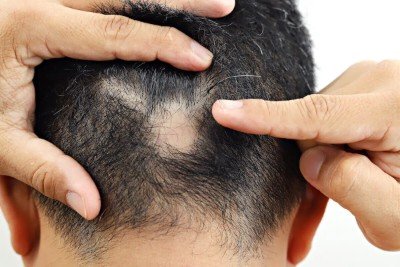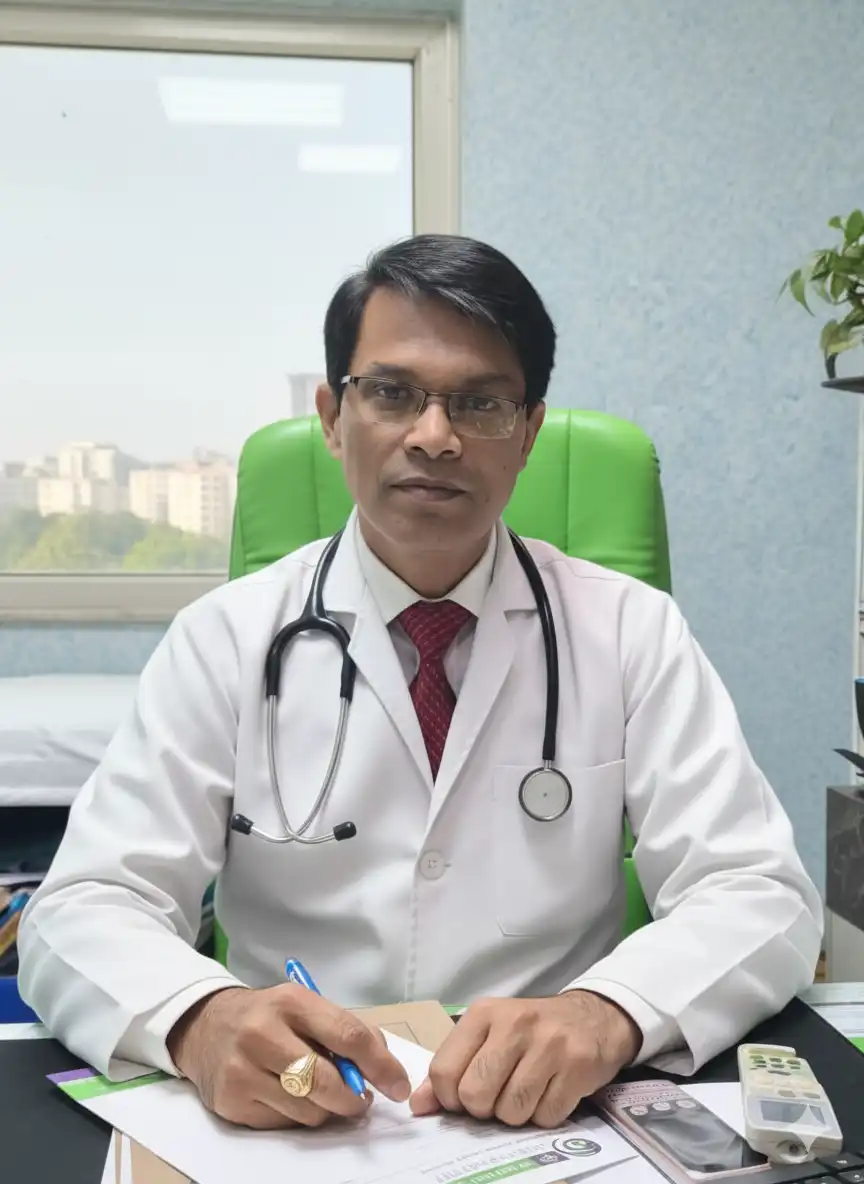
What is Alopecia Areata?
Alopecia areata is an autoimmune condition in which the body’s defence system, which usually protects us from infections, mistakenly starts attacking the hair follicles. This attack makes the hair weak and causes it to fall out, often in small, round or oval patches.

These bald spots are most commonly seen on the scalp, but they can also appear on the beard, eyebrows, eyelashes, or any other part of the body where hair grows. The size of the patches can vary from person to person, and in some cases, several patches may join together to form larger bald areas.
Even though the condition is not dangerous to overall health, the sudden loss of hair can create a lot of emotional stress and affect self-confidence.
Is Alopecia Areata contagious?
No, alopecia areata is not contagious at all. It cannot be passed from one person to another through touch, sharing combs, using the same pillow, or any kind of physical contact. It develops purely because of internal changes in the immune system and not because of bacteria, viruses, or fungi. This means patients can safely interact with their family, friends, and colleagues without worrying about spreading the condition.
What causes Alopecia Areata?
The main cause is an overactive immune system. In people with alopecia areata, the immune cells wrongly recognise the hair follicles as “foreign” and attack them. This sudden immune reaction pushes hair out of the growth phase, leading to patchy hair loss. Genetics also play an important role; if a family member has alopecia areata, eczema, asthma, or thyroid problems, the chances of developing alopecia areata may increase. Certain triggers, such as severe stress, viral infections, or hormonal changes, can also activate the condition in someone who is already genetically prone.
Can stress trigger Alopecia Areata?
Yes. Stress is not the only reason, but it is an important trigger. Many people notice that their hair starts falling out after a stressful life event, illness, or emotional disturbance. Stress causes chemical changes in the body that can disturb the immune balance and make the attack on hair follicles more active. That is why stress management—through meditation, yoga, exercise, or counselling—is often suggested along with medical treatment.
Is there a cure for Alopecia Areata?
Yes, in homeopathy, there is a cure for alopecia areata. Homoeopathy depends totality of symptoms, so it is important to take the case history from all the patients as an individual patient. In many cases, the timeline is unpredictable. For those with persistent patches or extensive hair loss, various medical treatments are available to control the condition and encourage hair regrowth. The goal of treatment is to calm down the immune attack, stimulate hair follicles, and maintain growth for as long as possible.
How is Alopecia Areata diagnosed?
Diagnosis is usually simple and does not require complicated tests. A dermatologist can often identify alopecia areata just by looking at the bald patches, as the condition has a very typical appearance. The doctor may gently pull the hair at the edges of the bald patch to see if it comes out easily, which is a sign of active disease. In some cases, blood tests are suggested to check for thyroid disease, vitamin deficiencies, or other autoimmune problems. Rarely, a skin biopsy may be done if the diagnosis is unclear.
What are the treatment options for Alopecia Areata in homeopathy?
In homoeopathy, treatment is individualised. The choice of medicine depends on the patient’s age, nature of bald patches, extent of hair loss, associated complaints (such as thyroid issues, stress, or autoimmune tendencies), and emotional state.
Common approaches include:
- Constitutional Medicines:
Selected based on the patient’s overall physical and mental makeup. They help correct the underlying immune imbalance that triggers hair loss. - Anti–Hair Fall Remedies:
Medicines like Phosphorus, Lycopodium, Silicea, Fluoric Acid, Thuja, Sepia, and Graphites are often considered, depending on symptoms. For example, patchy baldness with smooth skin may need a different remedy than hair loss after stress or illness. - Stress & Hormonal Balance:
Since stress, thyroid disorders, or PCOS can aggravate alopecia, remedies are given to stabilise these conditions naturally. - Scalp & Hair Support:
Gentle external applications like homeopathic hair tonics, oils, or mother tincture lotions may be advised to stimulate follicles and improve circulation. - Supportive Measures:
Guidance on diet (protein, iron, zinc-rich foods), stress management, and lifestyle corrections enhances results.
How Long Does Hair Regrowth Take in Alopecia Areata?
The timeline for hair regrowth in alopecia areata can be very different from person to person. In some individuals, small bald patches may start showing new hair within 6 to 12 weeks, while in others, the process may take several months or even longer. This unpredictability is one of the most challenging aspects of the condition.
The encouraging part is that in alopecia areata, the hair follicles are not permanently destroyed. They remain alive beneath the skin, which means the potential for regrowth is always present, even if hair loss looks severe. In many cases, the patches of hair may regrow on their own without any treatment, though medical support often speeds up the process and improves the chances of fuller regrowth.
The new hair that first appears may look different—it can be finer, softer, or even white in colour. Over time, as the follicles strengthen, the hair usually regains its natural thickness and colour. However, it is also possible that new patches of hair loss appear elsewhere even while older ones are regrowing, as the disease can have a “stop and start” pattern.
Overall, while there is no fixed timeline for recovery, regular treatment, stress management, and good nutrition can support faster and healthier regrowth. Patience and consistent follow-up with a doctor are key in managing this condition.
Will hair grow back normally?
Yes, most of the time hair grows back normally. In the beginning, the new hair may appear fine, thin, or even white in colour. Over time, as the follicles strengthen, the hair usually regains its normal thickness and colour. However, in some people, the patches may come and go, and the regrowth process may repeat multiple times.
Does Alopecia Areata Affect Nails or Other Parts of the Body?
Alopecia areata is most commonly noticed on the scalp, where small bald patches appear suddenly. However, the condition is not limited to scalp hair alone. In some individuals, it can involve other areas such as the eyebrows, eyelashes, beard, and body hair. This can make the condition more visible and, at times, more distressing for patients.
Apart from hair, alopecia areata can also affect the nails of the fingers and toes. Nail changes are seen in a significant number of patients and may serve as a clue that the disease is more active. Common nail signs include:
- Small pinpoint dents (known as nail pitting)
- Rough or brittle texture
- Vertical ridges running along the nail
- Thinning or weak nails
- In rare cases, nails may even split or become discoloured
These nail changes are usually harmless and do not cause pain, but they can sometimes interfere with daily activities or affect a person’s confidence. Importantly, when nail involvement is present, it often indicates that alopecia areata may be more persistent or severe, and it may require closer medical attention.
How common is Alopecia Areata?
Alopecia areata is fairly common. Studies suggest that about 1–2% of the global population will experience it at some point in life. It can occur in both men and women and can start at any age, including childhood. It does not discriminate between genders or ethnicities, making it a condition seen worldwide.
What support is available for patients in Homoeopathy?
Living with alopecia areata can affect not only appearance but also confidence and emotions. Homoeopathy provides support on three important levels:
- Medical Support (Gentle & Natural Care):
Individualised medicines aim to correct the immune imbalance, reduce hair fall, and stimulate regrowth—without the long-term side effects of steroids or immunosuppressants. Regular follow-ups help track progress and adjust remedies as needed. - Emotional & Psychological Support:
Many homeopathic consultations involve detailed case-taking, where patients can openly share their stress, fears, and feelings. The holistic approach helps in reducing anxiety, stress-related triggers, and improving overall mental well-being. - Lifestyle & Practical Guidance:
Doctors often advise on nutrition (protein, iron, zinc, biotin-rich foods), stress management, yoga, and simple scalp-care routines. Cosmetic aids such as wigs, hairpieces, or camouflage sprays may be suggested for confidence during recovery. - Community & Awareness:
Patients are encouraged to join awareness groups, online forums, or local communities where experiences can be shared. This emotional reassurance helps them stay motivated during treatment.
Can Lifestyle or Diet Help in Alopecia Areata?
While there is no single diet or lifestyle change that can completely cure alopecia areata, both nutrition and daily habits have a significant impact on the overall health of hair and the body’s immune system. Since alopecia areata is an autoimmune condition, strengthening the body from within can support better recovery and reduce flare-ups.
A balanced diet plays a crucial role. Foods rich in proteins, vitamins, and minerals help keep hair follicles strong and nourished. Fresh fruits, leafy green vegetables, nuts, seeds, legumes, and whole grains provide essential nutrients such as iron, zinc, biotin, and vitamin D—all of which are linked to healthy hair growth. On the other hand, limiting junk food, processed snacks, and foods high in sugar or unhealthy fats can prevent unnecessary inflammation in the body.
Lifestyle factors are equally important. Stress has been found to trigger or worsen alopecia areata in many people. Simple practices such as regular exercise, meditation, yoga, and proper sleep can calm the nervous system and improve immune balance. Avoiding smoking and alcohol also helps in maintaining better overall health.
Why Choose Dr. Sanjay’s Homoeopathy for Alopecia Areata Treatment in Lucknow, India?
Dr. Sanjay’s Homoeopathy is a trusted destination for safe and effective Alopecia Areata treatment in Lucknow, India. With years of expertise, Dr. Sanjay provides specialised alopecia areata homeopathic treatment in Lucknow, India, that not only controls hair fall but also stimulates natural hair regrowth without harmful side effects. Dr. Sanjay Singh is the Best Alopecia areata treatment doctor in Lucknow. As a leading homeopathic doctor in Lucknow, he follows international treatment standards and offers customised care plans to address the root cause of the disease. Patients prefer Dr. Sanjay’s Homoeopathy for its compassionate approach, holistic healing, and proven success in managing both early and advanced stages of alopecia areata.
Patients from across the world trust Dr. Sanjay’s Homoeopathy for Alopecia Areata Treatment in Lucknow, India. Dr. Sanjay Singh, who led this clinic, has successfully treated thousands of patients with Alopecia Areata. This makes him the best doctor for Alopecia Areata Treatment.
